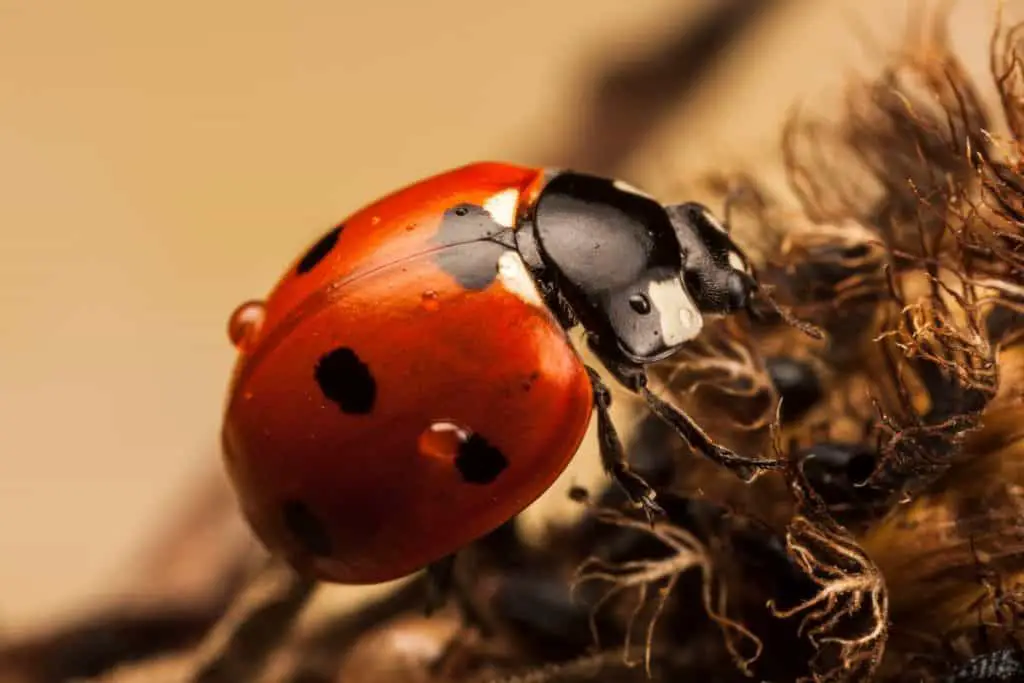There is a lot of debate about whether ladybugs are attracted to light or not. Some people swear that they have seen them fly towards the light, while others claim that this is nothing more than a myth.
So what is the truth? Are ladybugs attracted to light or not? The answer is that while ladybugs may be attracted to light, they are not necessarily drawn directly to it.
Ladybugs tend to be more drawn to areas where there is a lot of natural light, such as open fields or meadows.
But, what is it that attracts ladybugs to light? is it just visually appealing? or is it something else? Keep reading to find out…
Can Ladybugs Visually See Light?
The short answer is yes. Ladybugs’ have compound eyes that are able to see light, however, they have difficulty perceiving different colors and can only see shades of black, white, or grey.
Compound eyes are basically a type of insect eye where each eye is composed of many small, individual eyes, called ommatidia. The more ommatidia an insect has, the greater the detail in the image that the eye can see.
Each ommatidium is like a tiny camera, with its own lens and light-sensitive cell. The combination of all these images from all the ommatidia gives the insect a detailed view of its surroundings.
Compound eyes are found in a wide variety of insects, from flies and beetles to wasps and bees.
Most insects, including ladybugs contain between 3,000 and 9,000 ommatidia in each eye, while others, like dragonflies, have as many as 30,000. This makes dragonflies some of the best-sighted insects on the planet!
Thanks to their compound eyes, they can also detect fast-moving objects and react quickly to avoid them – which comes in handy when you’re trying to avoid being predators!
However, while Ladybugs may be able to see a bright light source, they cannot accurately determine the color of it.
Related Article:
So, Why Are Ladybugs Attracted To Light?
Most insects, are drawn to light due to a process known as ‘phototaxis’. Phototaxis is the tendency of an animal to move towards or away from a source of light.
This can be further broken down into two categories: positive phototaxis (moving towards a light source) and negative phototaxis (moving away from a light source).
Positive Phototaxis
Positive Phototaxis is the movement of an organism in response to a light stimulus. An animal that is positively phototactic will move towards the source of light, while one that is negatively phototactic will move away from the light.
In insects, phototaxis is used as a means of navigation! For example, many moths are drawn to artificial lights, such as streetlights or porch lights.
This behavior is known as trap-lining, and it helps the moths or other insects like ladybugs to find mates and food sources. Similarly, fireflies use phototaxis to communicate with potential mates.
The male firefly will flash its light in a specific pattern, and the female will respond with her own flash if she is interested. In both cases, phototaxis plays an important role in the life cycle of these insects.

Negative Phototaxis
Negative phototaxis is an innate behavior in many insects, whereby they actively move away from light. This behavior is usually exhibited in response to ultraviolet (UV) light, but can also be triggered by visible light, depending on the species.
While the exact mechanism underlying negative phototaxis is not fully understood, it is thought to be a way for insects to avoid predation or UV damage.
In some cases, negative phototaxis can be used to control insect pests, as they will actively move away from light-emitting traps.
However, this method is not always effective, as some insects are able to adapt their behavior and become less responsive to light over time.
In the case of ladybugs, they tend to have positive phototaxis when it comes to light sources, which is why they may be seen flying around artificial lights during the day – or even at night in some cases!
Related Article:
Types Of Light That Ladybugs Are Attracted To
There are several different types of light that ladybugs are attracted to, from the exteriors of light-colored homes to natural light sources Some of the most common light sources that attract ladybugs are:
- UV Lights
- Street Lamps
- Outdoor Porch Lights
- Solar Powered Lights
- Garden Spotlights
It’s important to note that ladybugs may be attracted to certain kinds of lights (such as those listed above) but they may not necessarily stay there for long.
Ladybugs may only stay near a light source briefly before moving on in search of food or a mate.
If you find that you have a lot of ladybirds in your home it may not be because of the light, but because the insect is looking for warmth or shelter.
Are Ladybugs Attracted To Light Traps?
Light traps are designed to attract and capture pests, but unfortunately, this includes ladybugs. Light traps can be an effective way of controlling a ladybug infestation, as they are attracted to bright lights and can easily become trapped in them.
However, this isn’t the most humane or environmentally friendly method of removing ladybugs after all they’re beneficial to the environment.
A better way to rid your home of ladybugs is to use natural pest repellents like essential oils or garlic as they are not life takers like light traps.
Also, remember they are attached to heat so all because they are buzzing around your lights and trying to get into your house, this doesn’t always mean they are attached to the light!
This could be because the ladybugs are looking for warmth!
Conclusion
So while Ladybugs can see light and be attracted to light, they are not necessarily drawn directly to it.
But, as already mentioned remember if you have a problem with ladybugs and your notice large groups trying to nest in your home it could be because of the heat.
Related Article:
